Nursing Education & Oral Care to Reduce VAP - Project Part 1
VerifiedAdded on 2023/06/11
|20
|4598
|174
Project
AI Summary
This project investigates the impact of oral care practices on reducing ventilator-associated pneumonia (VAP) in mechanically ventilated patients. It highlights the significance of evidence-based nursing pre-education programs focused on oral hygiene. The study uses a PICOT question to guide the inquiry, examining the effectiveness of oral care interventions, including chlorhexidine-based solutions and tooth brushing, in decreasing VAP rates. A literature review with annotated bibliography presents various research findings, comparing different oral hygiene treatments and their effects on VAP incidence. The project also proposes a methodology for future studies, considering ethical implications and limitations, ultimately aiming to improve patient outcomes and reduce healthcare costs associated with VAP. Desklib provides access to similar projects and study resources for students.
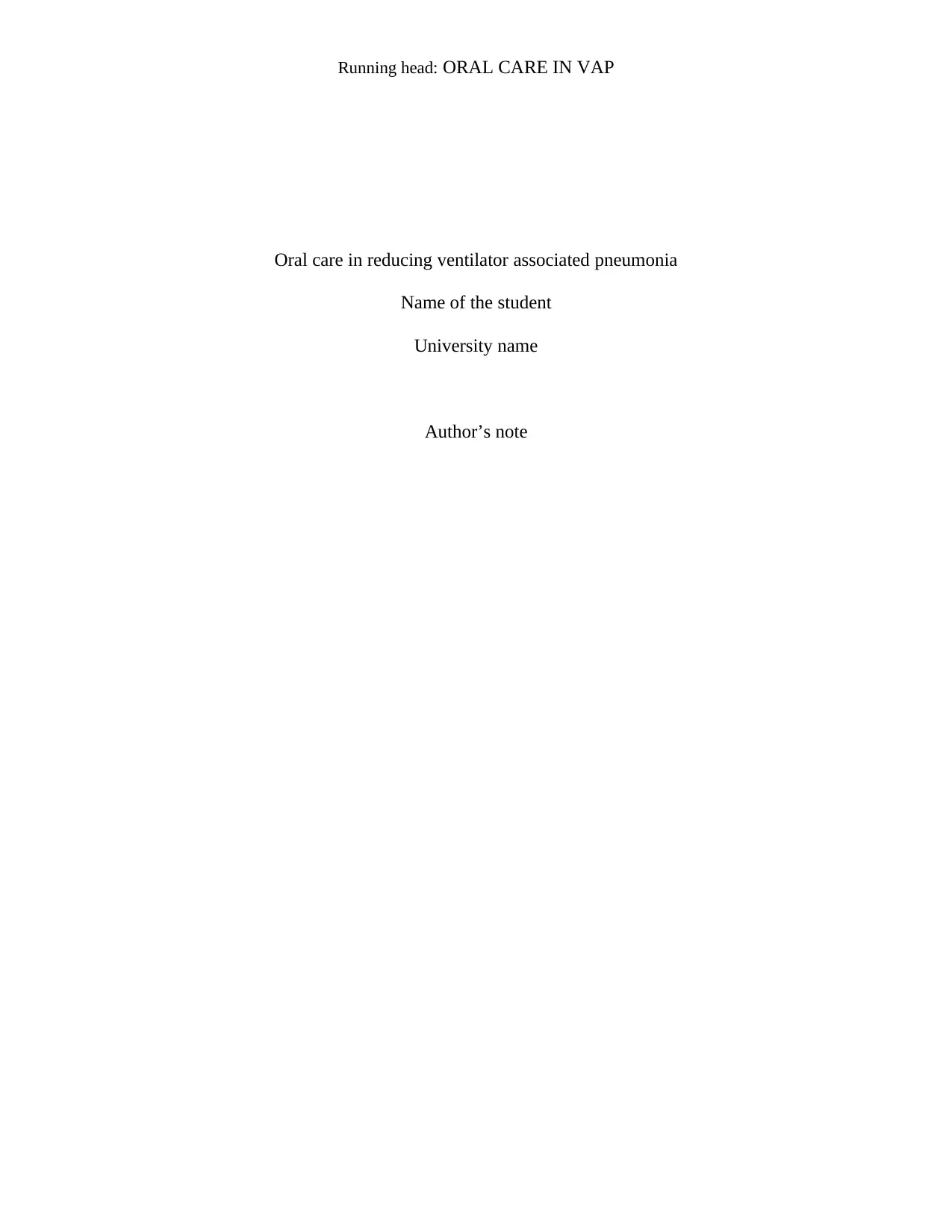
Running head: ORAL CARE IN VAP
Oral care in reducing ventilator associated pneumonia
Name of the student
University name
Author’s note
Oral care in reducing ventilator associated pneumonia
Name of the student
University name
Author’s note
Paraphrase This Document
Need a fresh take? Get an instant paraphrase of this document with our AI Paraphraser
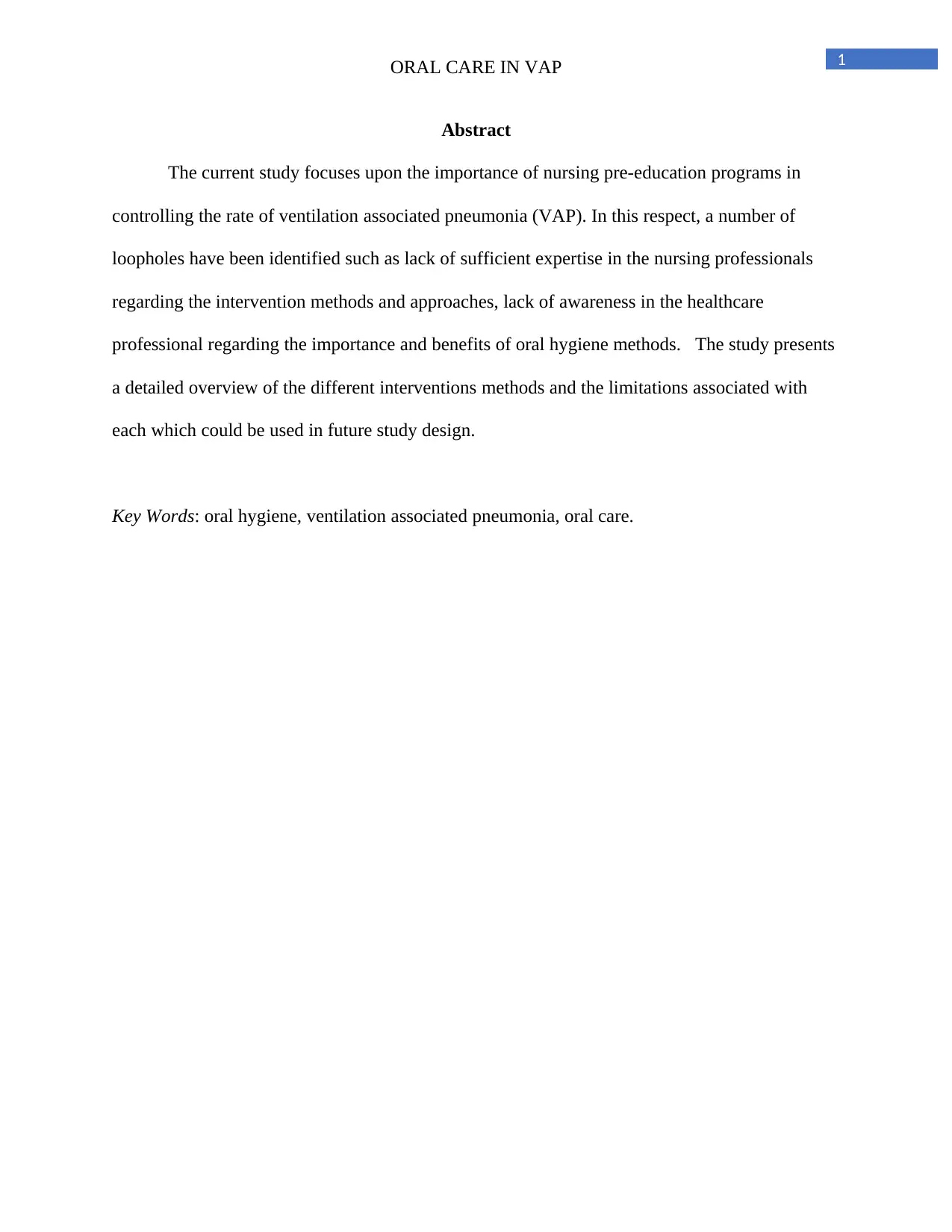
1ORAL CARE IN VAP
Abstract
The current study focuses upon the importance of nursing pre-education programs in
controlling the rate of ventilation associated pneumonia (VAP). In this respect, a number of
loopholes have been identified such as lack of sufficient expertise in the nursing professionals
regarding the intervention methods and approaches, lack of awareness in the healthcare
professional regarding the importance and benefits of oral hygiene methods. The study presents
a detailed overview of the different interventions methods and the limitations associated with
each which could be used in future study design.
Key Words: oral hygiene, ventilation associated pneumonia, oral care.
Abstract
The current study focuses upon the importance of nursing pre-education programs in
controlling the rate of ventilation associated pneumonia (VAP). In this respect, a number of
loopholes have been identified such as lack of sufficient expertise in the nursing professionals
regarding the intervention methods and approaches, lack of awareness in the healthcare
professional regarding the importance and benefits of oral hygiene methods. The study presents
a detailed overview of the different interventions methods and the limitations associated with
each which could be used in future study design.
Key Words: oral hygiene, ventilation associated pneumonia, oral care.
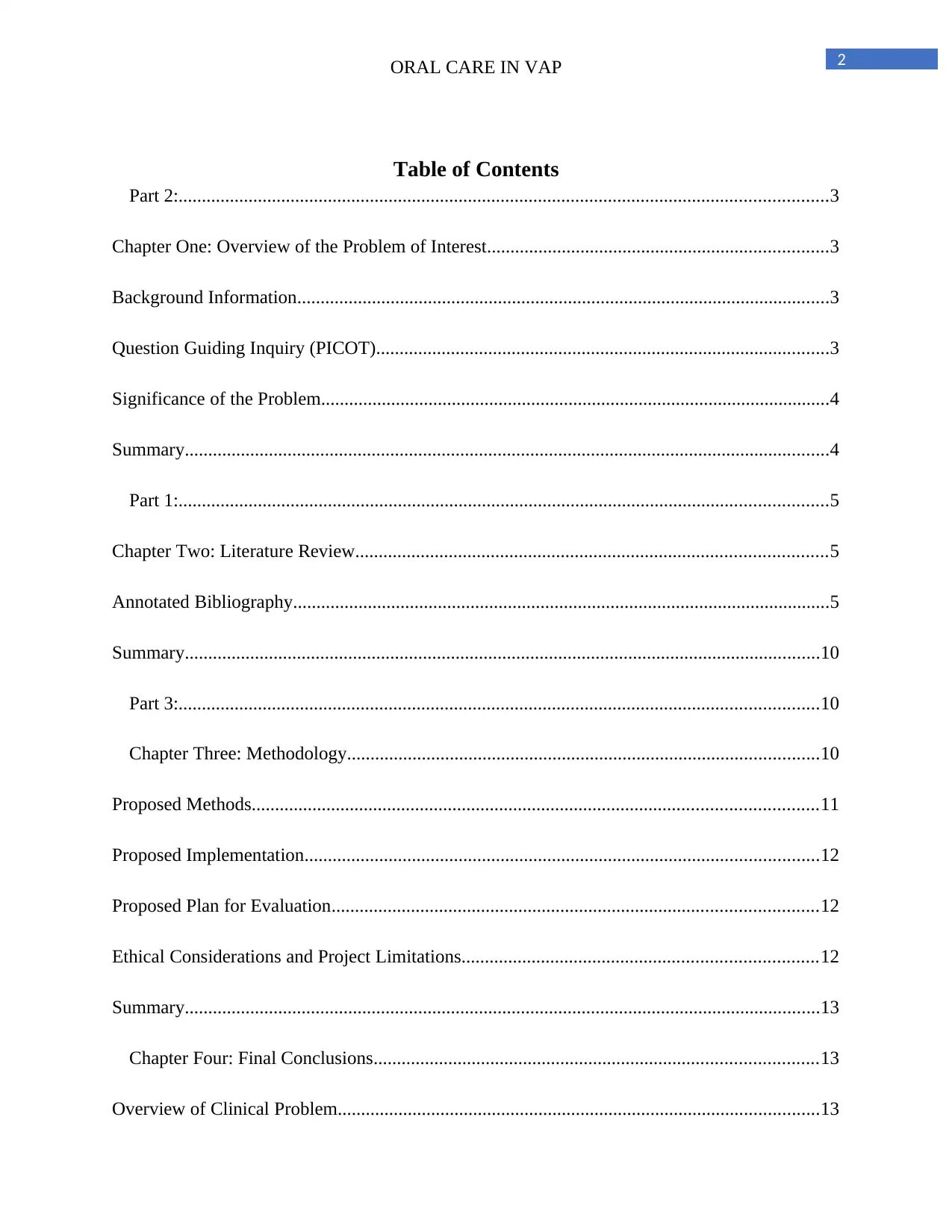
2ORAL CARE IN VAP
Table of Contents
Part 2:...........................................................................................................................................3
Chapter One: Overview of the Problem of Interest.........................................................................3
Background Information..................................................................................................................3
Question Guiding Inquiry (PICOT).................................................................................................3
Significance of the Problem.............................................................................................................4
Summary..........................................................................................................................................4
Part 1:...........................................................................................................................................5
Chapter Two: Literature Review.....................................................................................................5
Annotated Bibliography...................................................................................................................5
Summary........................................................................................................................................10
Part 3:.........................................................................................................................................10
Chapter Three: Methodology.....................................................................................................10
Proposed Methods.........................................................................................................................11
Proposed Implementation..............................................................................................................12
Proposed Plan for Evaluation........................................................................................................12
Ethical Considerations and Project Limitations............................................................................12
Summary........................................................................................................................................13
Chapter Four: Final Conclusions...............................................................................................13
Overview of Clinical Problem.......................................................................................................13
Table of Contents
Part 2:...........................................................................................................................................3
Chapter One: Overview of the Problem of Interest.........................................................................3
Background Information..................................................................................................................3
Question Guiding Inquiry (PICOT).................................................................................................3
Significance of the Problem.............................................................................................................4
Summary..........................................................................................................................................4
Part 1:...........................................................................................................................................5
Chapter Two: Literature Review.....................................................................................................5
Annotated Bibliography...................................................................................................................5
Summary........................................................................................................................................10
Part 3:.........................................................................................................................................10
Chapter Three: Methodology.....................................................................................................10
Proposed Methods.........................................................................................................................11
Proposed Implementation..............................................................................................................12
Proposed Plan for Evaluation........................................................................................................12
Ethical Considerations and Project Limitations............................................................................12
Summary........................................................................................................................................13
Chapter Four: Final Conclusions...............................................................................................13
Overview of Clinical Problem.......................................................................................................13
⊘ This is a preview!⊘
Do you want full access?
Subscribe today to unlock all pages.

Trusted by 1+ million students worldwide
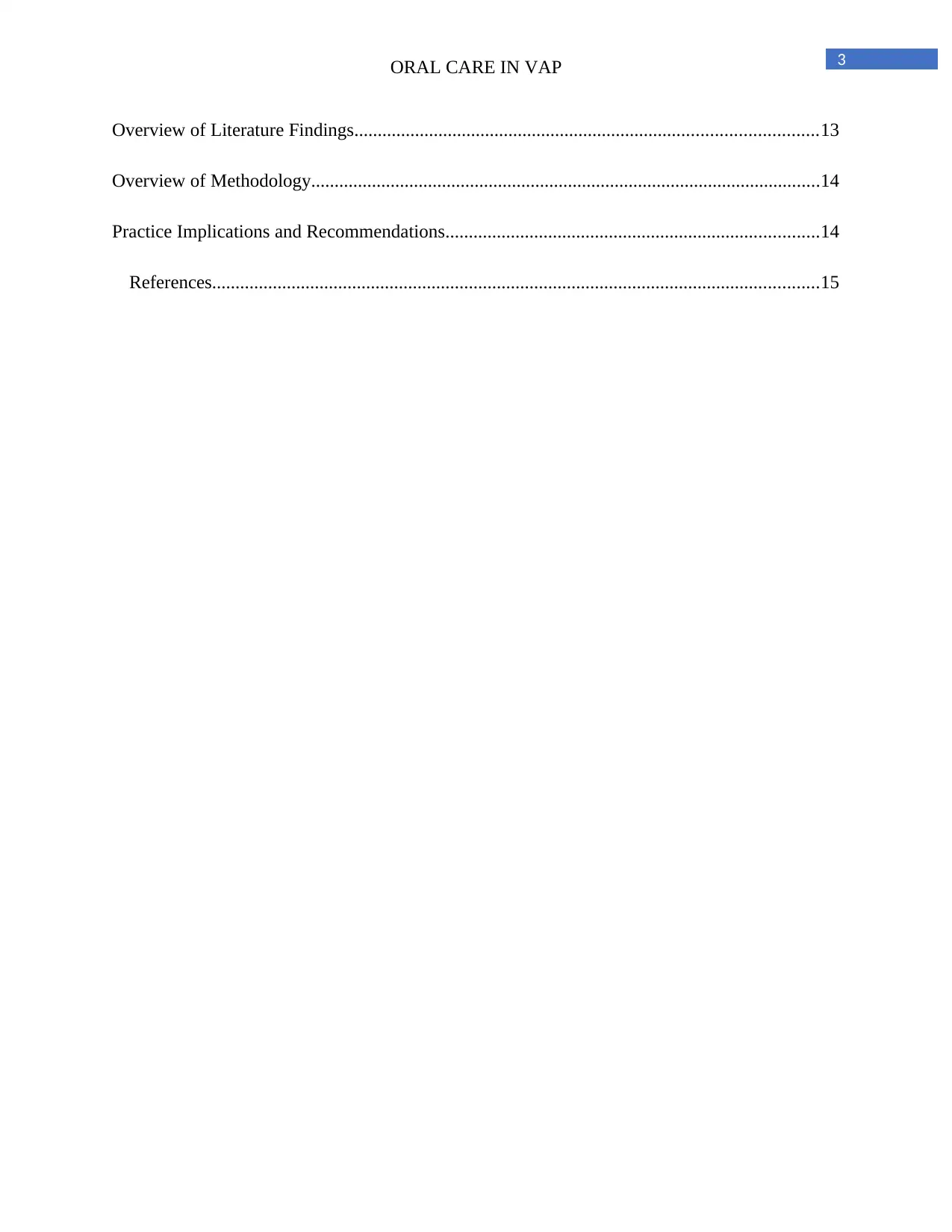
3ORAL CARE IN VAP
Overview of Literature Findings...................................................................................................13
Overview of Methodology.............................................................................................................14
Practice Implications and Recommendations................................................................................14
References..................................................................................................................................15
Overview of Literature Findings...................................................................................................13
Overview of Methodology.............................................................................................................14
Practice Implications and Recommendations................................................................................14
References..................................................................................................................................15
Paraphrase This Document
Need a fresh take? Get an instant paraphrase of this document with our AI Paraphraser
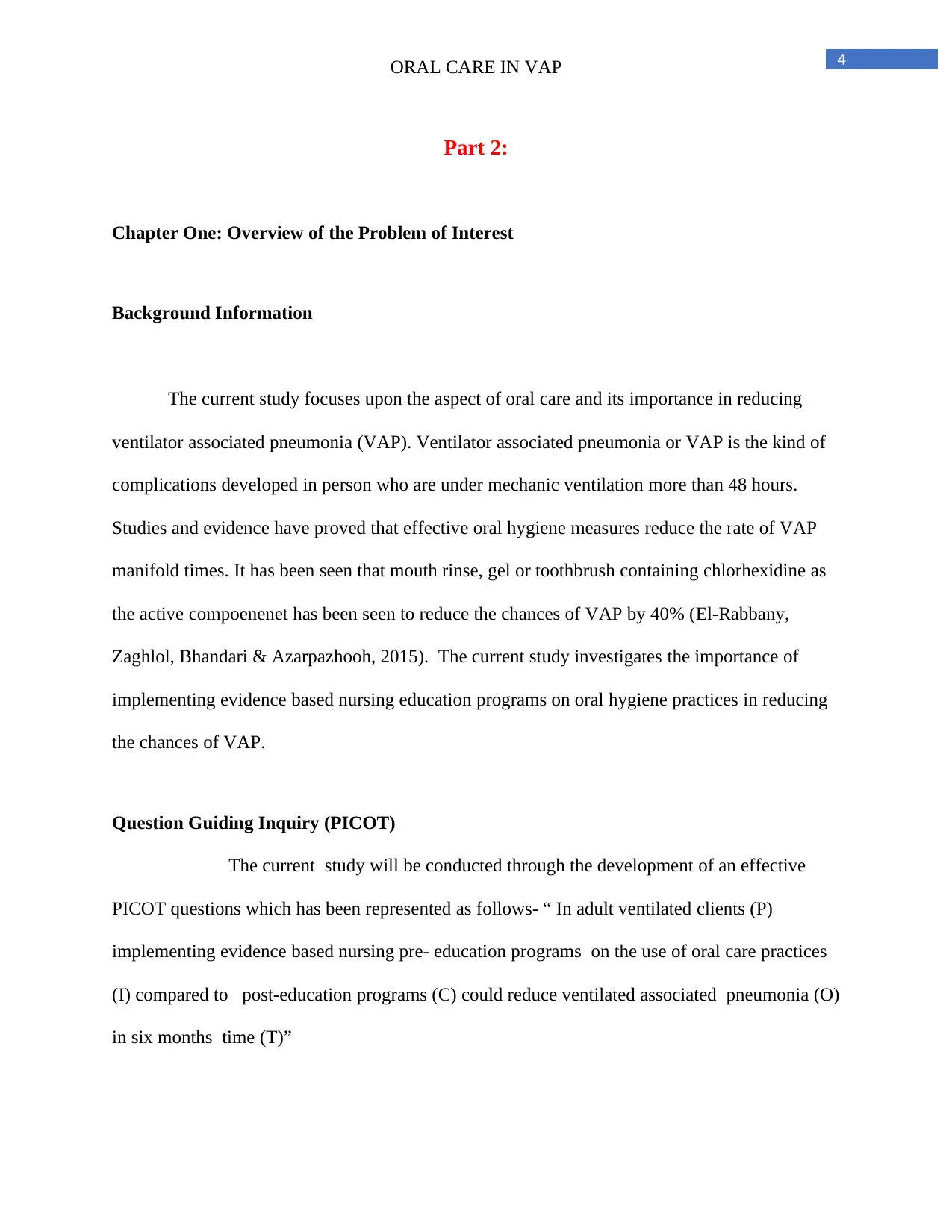
4ORAL CARE IN VAP
Part 2:
Chapter One: Overview of the Problem of Interest
Background Information
The current study focuses upon the aspect of oral care and its importance in reducing
ventilator associated pneumonia (VAP). Ventilator associated pneumonia or VAP is the kind of
complications developed in person who are under mechanic ventilation more than 48 hours.
Studies and evidence have proved that effective oral hygiene measures reduce the rate of VAP
manifold times. It has been seen that mouth rinse, gel or toothbrush containing chlorhexidine as
the active compoenenet has been seen to reduce the chances of VAP by 40% (El-Rabbany,
Zaghlol, Bhandari & Azarpazhooh, 2015). The current study investigates the importance of
implementing evidence based nursing education programs on oral hygiene practices in reducing
the chances of VAP.
Question Guiding Inquiry (PICOT)
The current study will be conducted through the development of an effective
PICOT questions which has been represented as follows- “ In adult ventilated clients (P)
implementing evidence based nursing pre- education programs on the use of oral care practices
(I) compared to post-education programs (C) could reduce ventilated associated pneumonia (O)
in six months time (T)”
Part 2:
Chapter One: Overview of the Problem of Interest
Background Information
The current study focuses upon the aspect of oral care and its importance in reducing
ventilator associated pneumonia (VAP). Ventilator associated pneumonia or VAP is the kind of
complications developed in person who are under mechanic ventilation more than 48 hours.
Studies and evidence have proved that effective oral hygiene measures reduce the rate of VAP
manifold times. It has been seen that mouth rinse, gel or toothbrush containing chlorhexidine as
the active compoenenet has been seen to reduce the chances of VAP by 40% (El-Rabbany,
Zaghlol, Bhandari & Azarpazhooh, 2015). The current study investigates the importance of
implementing evidence based nursing education programs on oral hygiene practices in reducing
the chances of VAP.
Question Guiding Inquiry (PICOT)
The current study will be conducted through the development of an effective
PICOT questions which has been represented as follows- “ In adult ventilated clients (P)
implementing evidence based nursing pre- education programs on the use of oral care practices
(I) compared to post-education programs (C) could reduce ventilated associated pneumonia (O)
in six months time (T)”
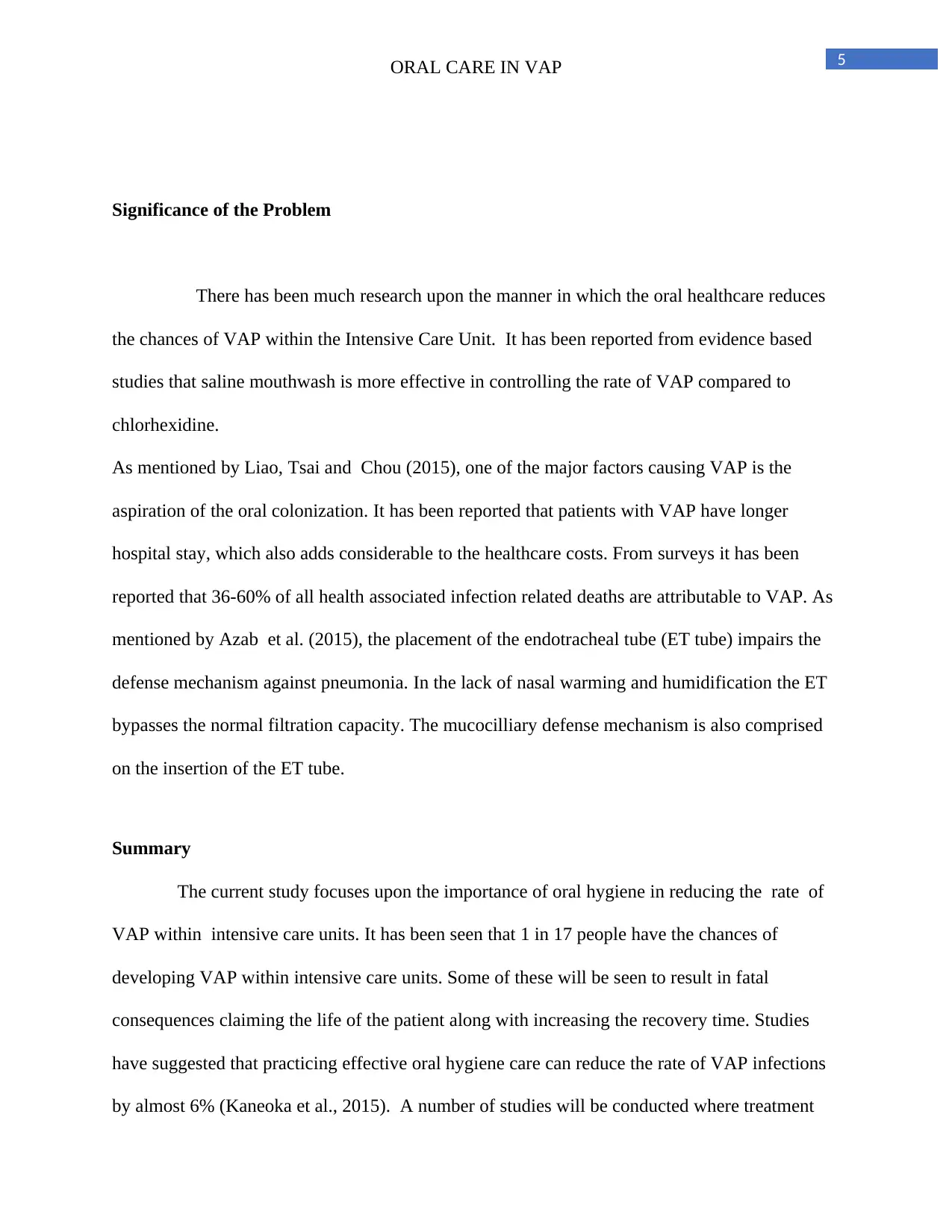
5ORAL CARE IN VAP
Significance of the Problem
There has been much research upon the manner in which the oral healthcare reduces
the chances of VAP within the Intensive Care Unit. It has been reported from evidence based
studies that saline mouthwash is more effective in controlling the rate of VAP compared to
chlorhexidine.
As mentioned by Liao, Tsai and Chou (2015), one of the major factors causing VAP is the
aspiration of the oral colonization. It has been reported that patients with VAP have longer
hospital stay, which also adds considerable to the healthcare costs. From surveys it has been
reported that 36-60% of all health associated infection related deaths are attributable to VAP. As
mentioned by Azab et al. (2015), the placement of the endotracheal tube (ET tube) impairs the
defense mechanism against pneumonia. In the lack of nasal warming and humidification the ET
bypasses the normal filtration capacity. The mucocilliary defense mechanism is also comprised
on the insertion of the ET tube.
Summary
The current study focuses upon the importance of oral hygiene in reducing the rate of
VAP within intensive care units. It has been seen that 1 in 17 people have the chances of
developing VAP within intensive care units. Some of these will be seen to result in fatal
consequences claiming the life of the patient along with increasing the recovery time. Studies
have suggested that practicing effective oral hygiene care can reduce the rate of VAP infections
by almost 6% (Kaneoka et al., 2015). A number of studies will be conducted where treatment
Significance of the Problem
There has been much research upon the manner in which the oral healthcare reduces
the chances of VAP within the Intensive Care Unit. It has been reported from evidence based
studies that saline mouthwash is more effective in controlling the rate of VAP compared to
chlorhexidine.
As mentioned by Liao, Tsai and Chou (2015), one of the major factors causing VAP is the
aspiration of the oral colonization. It has been reported that patients with VAP have longer
hospital stay, which also adds considerable to the healthcare costs. From surveys it has been
reported that 36-60% of all health associated infection related deaths are attributable to VAP. As
mentioned by Azab et al. (2015), the placement of the endotracheal tube (ET tube) impairs the
defense mechanism against pneumonia. In the lack of nasal warming and humidification the ET
bypasses the normal filtration capacity. The mucocilliary defense mechanism is also comprised
on the insertion of the ET tube.
Summary
The current study focuses upon the importance of oral hygiene in reducing the rate of
VAP within intensive care units. It has been seen that 1 in 17 people have the chances of
developing VAP within intensive care units. Some of these will be seen to result in fatal
consequences claiming the life of the patient along with increasing the recovery time. Studies
have suggested that practicing effective oral hygiene care can reduce the rate of VAP infections
by almost 6% (Kaneoka et al., 2015). A number of studies will be conducted where treatment
⊘ This is a preview!⊘
Do you want full access?
Subscribe today to unlock all pages.

Trusted by 1+ million students worldwide
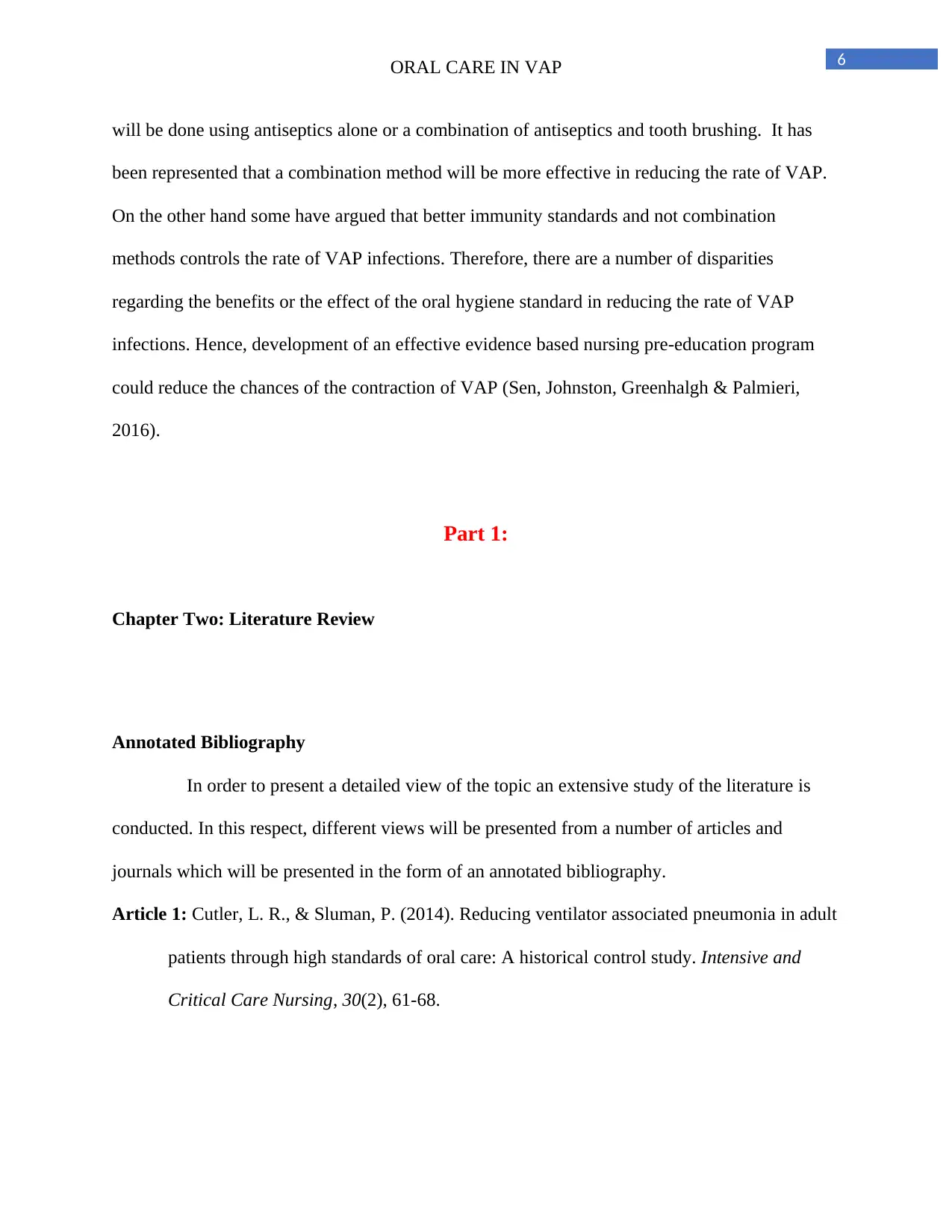
6ORAL CARE IN VAP
will be done using antiseptics alone or a combination of antiseptics and tooth brushing. It has
been represented that a combination method will be more effective in reducing the rate of VAP.
On the other hand some have argued that better immunity standards and not combination
methods controls the rate of VAP infections. Therefore, there are a number of disparities
regarding the benefits or the effect of the oral hygiene standard in reducing the rate of VAP
infections. Hence, development of an effective evidence based nursing pre-education program
could reduce the chances of the contraction of VAP (Sen, Johnston, Greenhalgh & Palmieri,
2016).
Part 1:
Chapter Two: Literature Review
Annotated Bibliography
In order to present a detailed view of the topic an extensive study of the literature is
conducted. In this respect, different views will be presented from a number of articles and
journals which will be presented in the form of an annotated bibliography.
Article 1: Cutler, L. R., & Sluman, P. (2014). Reducing ventilator associated pneumonia in adult
patients through high standards of oral care: A historical control study. Intensive and
Critical Care Nursing, 30(2), 61-68.
will be done using antiseptics alone or a combination of antiseptics and tooth brushing. It has
been represented that a combination method will be more effective in reducing the rate of VAP.
On the other hand some have argued that better immunity standards and not combination
methods controls the rate of VAP infections. Therefore, there are a number of disparities
regarding the benefits or the effect of the oral hygiene standard in reducing the rate of VAP
infections. Hence, development of an effective evidence based nursing pre-education program
could reduce the chances of the contraction of VAP (Sen, Johnston, Greenhalgh & Palmieri,
2016).
Part 1:
Chapter Two: Literature Review
Annotated Bibliography
In order to present a detailed view of the topic an extensive study of the literature is
conducted. In this respect, different views will be presented from a number of articles and
journals which will be presented in the form of an annotated bibliography.
Article 1: Cutler, L. R., & Sluman, P. (2014). Reducing ventilator associated pneumonia in adult
patients through high standards of oral care: A historical control study. Intensive and
Critical Care Nursing, 30(2), 61-68.
Paraphrase This Document
Need a fresh take? Get an instant paraphrase of this document with our AI Paraphraser
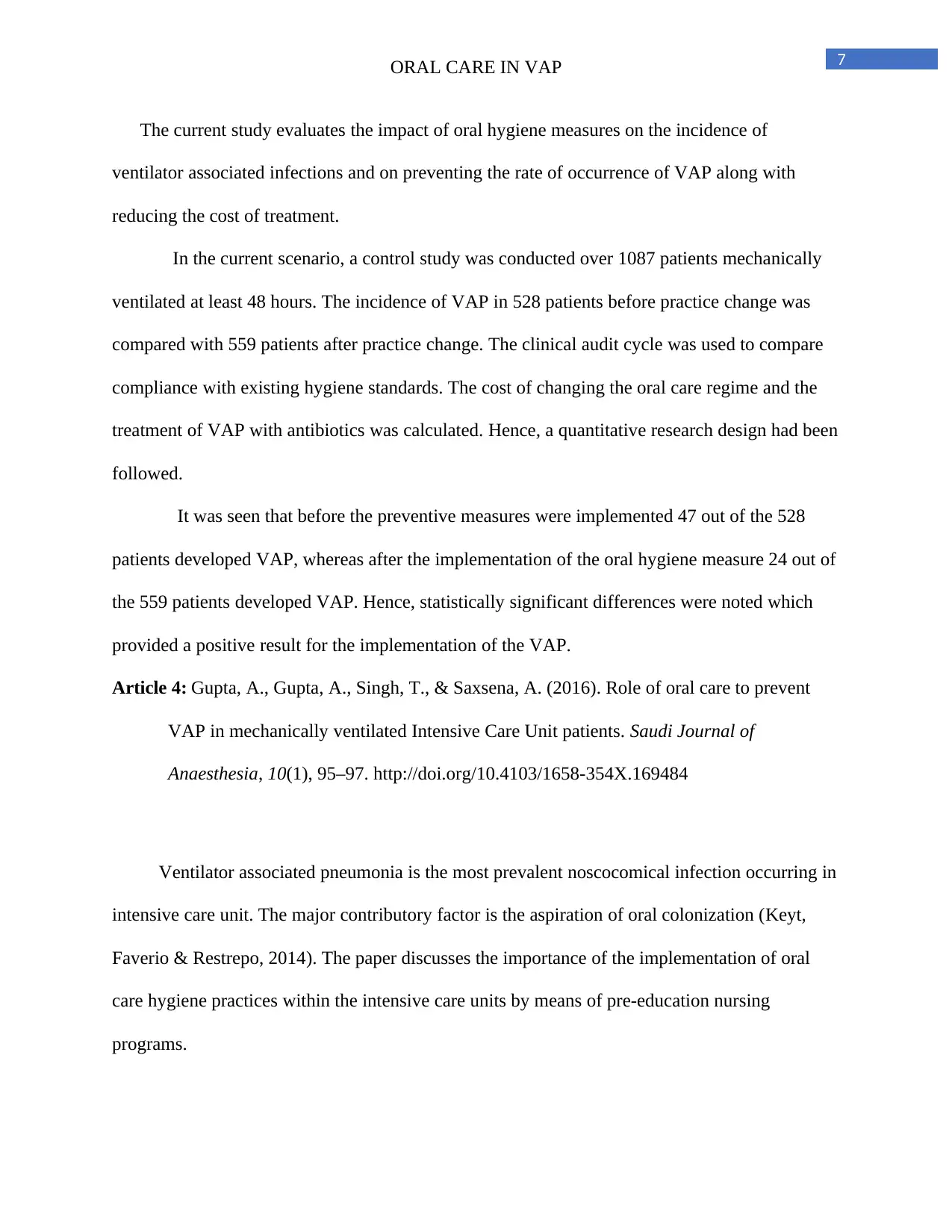
7ORAL CARE IN VAP
The current study evaluates the impact of oral hygiene measures on the incidence of
ventilator associated infections and on preventing the rate of occurrence of VAP along with
reducing the cost of treatment.
In the current scenario, a control study was conducted over 1087 patients mechanically
ventilated at least 48 hours. The incidence of VAP in 528 patients before practice change was
compared with 559 patients after practice change. The clinical audit cycle was used to compare
compliance with existing hygiene standards. The cost of changing the oral care regime and the
treatment of VAP with antibiotics was calculated. Hence, a quantitative research design had been
followed.
It was seen that before the preventive measures were implemented 47 out of the 528
patients developed VAP, whereas after the implementation of the oral hygiene measure 24 out of
the 559 patients developed VAP. Hence, statistically significant differences were noted which
provided a positive result for the implementation of the VAP.
Article 4: Gupta, A., Gupta, A., Singh, T., & Saxsena, A. (2016). Role of oral care to prevent
VAP in mechanically ventilated Intensive Care Unit patients. Saudi Journal of
Anaesthesia, 10(1), 95–97. http://doi.org/10.4103/1658-354X.169484
Ventilator associated pneumonia is the most prevalent noscocomical infection occurring in
intensive care unit. The major contributory factor is the aspiration of oral colonization (Keyt,
Faverio & Restrepo, 2014). The paper discusses the importance of the implementation of oral
care hygiene practices within the intensive care units by means of pre-education nursing
programs.
The current study evaluates the impact of oral hygiene measures on the incidence of
ventilator associated infections and on preventing the rate of occurrence of VAP along with
reducing the cost of treatment.
In the current scenario, a control study was conducted over 1087 patients mechanically
ventilated at least 48 hours. The incidence of VAP in 528 patients before practice change was
compared with 559 patients after practice change. The clinical audit cycle was used to compare
compliance with existing hygiene standards. The cost of changing the oral care regime and the
treatment of VAP with antibiotics was calculated. Hence, a quantitative research design had been
followed.
It was seen that before the preventive measures were implemented 47 out of the 528
patients developed VAP, whereas after the implementation of the oral hygiene measure 24 out of
the 559 patients developed VAP. Hence, statistically significant differences were noted which
provided a positive result for the implementation of the VAP.
Article 4: Gupta, A., Gupta, A., Singh, T., & Saxsena, A. (2016). Role of oral care to prevent
VAP in mechanically ventilated Intensive Care Unit patients. Saudi Journal of
Anaesthesia, 10(1), 95–97. http://doi.org/10.4103/1658-354X.169484
Ventilator associated pneumonia is the most prevalent noscocomical infection occurring in
intensive care unit. The major contributory factor is the aspiration of oral colonization (Keyt,
Faverio & Restrepo, 2014). The paper discusses the importance of the implementation of oral
care hygiene practices within the intensive care units by means of pre-education nursing
programs.
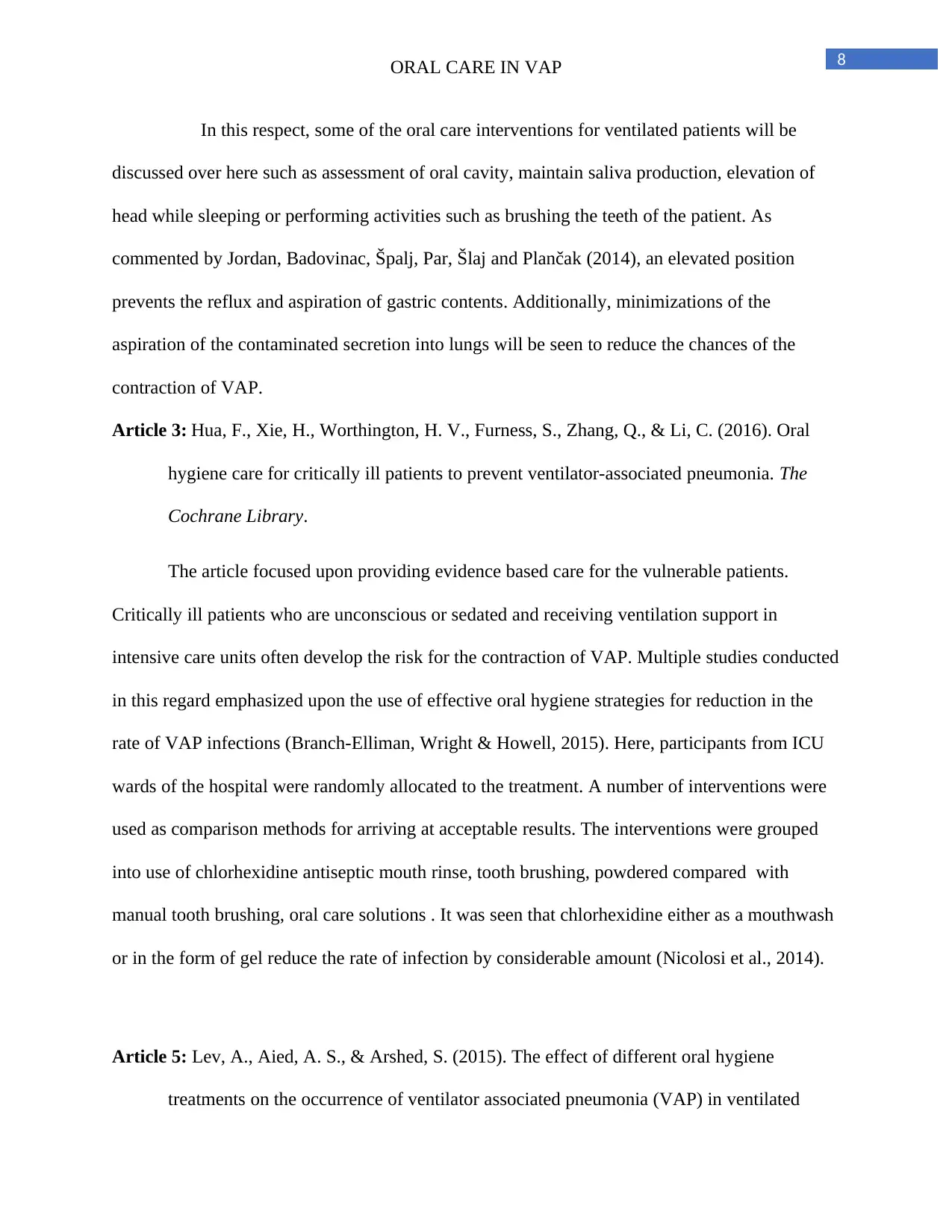
8ORAL CARE IN VAP
In this respect, some of the oral care interventions for ventilated patients will be
discussed over here such as assessment of oral cavity, maintain saliva production, elevation of
head while sleeping or performing activities such as brushing the teeth of the patient. As
commented by Jordan, Badovinac, Špalj, Par, Šlaj and Plančak (2014), an elevated position
prevents the reflux and aspiration of gastric contents. Additionally, minimizations of the
aspiration of the contaminated secretion into lungs will be seen to reduce the chances of the
contraction of VAP.
Article 3: Hua, F., Xie, H., Worthington, H. V., Furness, S., Zhang, Q., & Li, C. (2016). Oral
hygiene care for critically ill patients to prevent ventilator‐associated pneumonia. The
Cochrane Library.
The article focused upon providing evidence based care for the vulnerable patients.
Critically ill patients who are unconscious or sedated and receiving ventilation support in
intensive care units often develop the risk for the contraction of VAP. Multiple studies conducted
in this regard emphasized upon the use of effective oral hygiene strategies for reduction in the
rate of VAP infections (Branch-Elliman, Wright & Howell, 2015). Here, participants from ICU
wards of the hospital were randomly allocated to the treatment. A number of interventions were
used as comparison methods for arriving at acceptable results. The interventions were grouped
into use of chlorhexidine antiseptic mouth rinse, tooth brushing, powdered compared with
manual tooth brushing, oral care solutions . It was seen that chlorhexidine either as a mouthwash
or in the form of gel reduce the rate of infection by considerable amount (Nicolosi et al., 2014).
Article 5: Lev, A., Aied, A. S., & Arshed, S. (2015). The effect of different oral hygiene
treatments on the occurrence of ventilator associated pneumonia (VAP) in ventilated
In this respect, some of the oral care interventions for ventilated patients will be
discussed over here such as assessment of oral cavity, maintain saliva production, elevation of
head while sleeping or performing activities such as brushing the teeth of the patient. As
commented by Jordan, Badovinac, Špalj, Par, Šlaj and Plančak (2014), an elevated position
prevents the reflux and aspiration of gastric contents. Additionally, minimizations of the
aspiration of the contaminated secretion into lungs will be seen to reduce the chances of the
contraction of VAP.
Article 3: Hua, F., Xie, H., Worthington, H. V., Furness, S., Zhang, Q., & Li, C. (2016). Oral
hygiene care for critically ill patients to prevent ventilator‐associated pneumonia. The
Cochrane Library.
The article focused upon providing evidence based care for the vulnerable patients.
Critically ill patients who are unconscious or sedated and receiving ventilation support in
intensive care units often develop the risk for the contraction of VAP. Multiple studies conducted
in this regard emphasized upon the use of effective oral hygiene strategies for reduction in the
rate of VAP infections (Branch-Elliman, Wright & Howell, 2015). Here, participants from ICU
wards of the hospital were randomly allocated to the treatment. A number of interventions were
used as comparison methods for arriving at acceptable results. The interventions were grouped
into use of chlorhexidine antiseptic mouth rinse, tooth brushing, powdered compared with
manual tooth brushing, oral care solutions . It was seen that chlorhexidine either as a mouthwash
or in the form of gel reduce the rate of infection by considerable amount (Nicolosi et al., 2014).
Article 5: Lev, A., Aied, A. S., & Arshed, S. (2015). The effect of different oral hygiene
treatments on the occurrence of ventilator associated pneumonia (VAP) in ventilated
⊘ This is a preview!⊘
Do you want full access?
Subscribe today to unlock all pages.

Trusted by 1+ million students worldwide
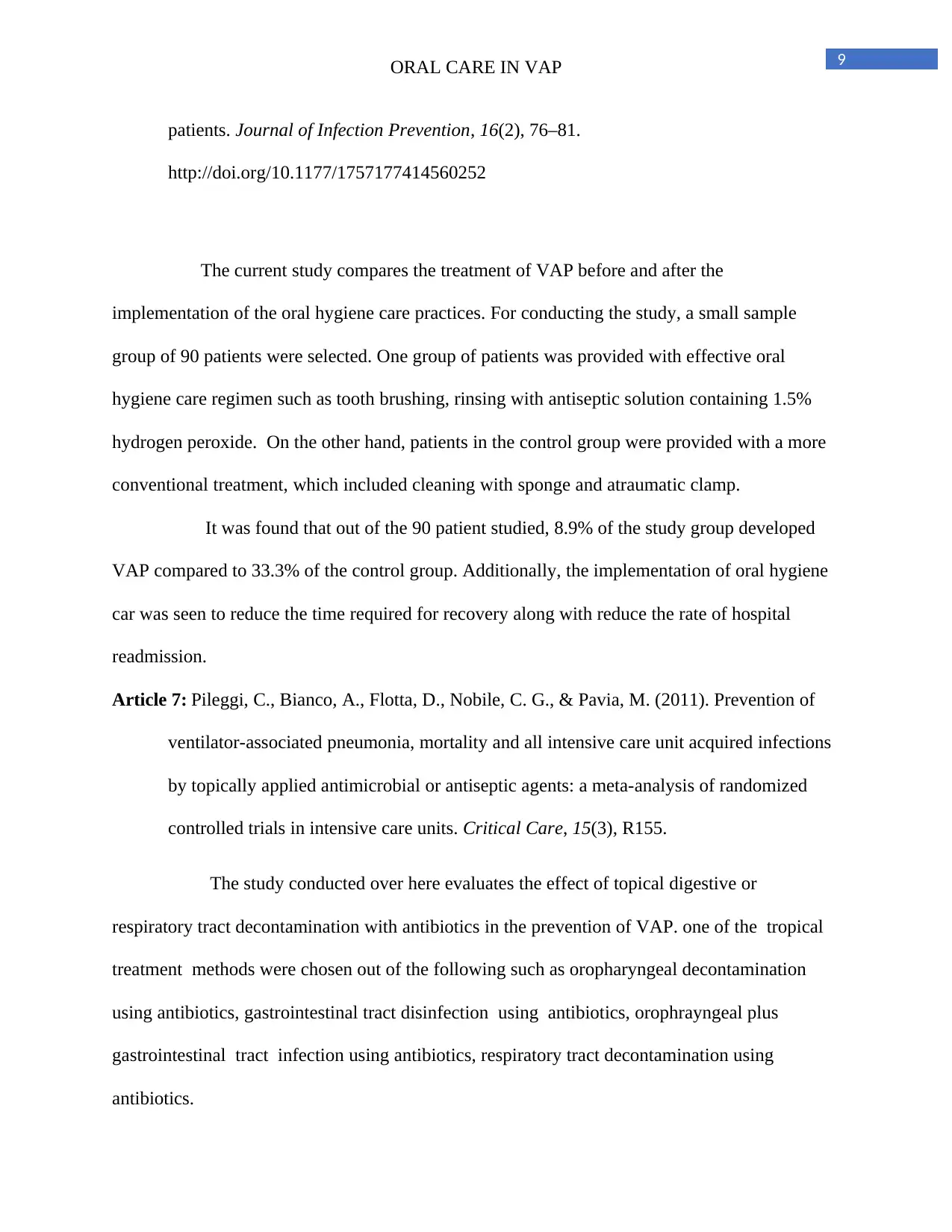
9ORAL CARE IN VAP
patients. Journal of Infection Prevention, 16(2), 76–81.
http://doi.org/10.1177/1757177414560252
The current study compares the treatment of VAP before and after the
implementation of the oral hygiene care practices. For conducting the study, a small sample
group of 90 patients were selected. One group of patients was provided with effective oral
hygiene care regimen such as tooth brushing, rinsing with antiseptic solution containing 1.5%
hydrogen peroxide. On the other hand, patients in the control group were provided with a more
conventional treatment, which included cleaning with sponge and atraumatic clamp.
It was found that out of the 90 patient studied, 8.9% of the study group developed
VAP compared to 33.3% of the control group. Additionally, the implementation of oral hygiene
car was seen to reduce the time required for recovery along with reduce the rate of hospital
readmission.
Article 7: Pileggi, C., Bianco, A., Flotta, D., Nobile, C. G., & Pavia, M. (2011). Prevention of
ventilator-associated pneumonia, mortality and all intensive care unit acquired infections
by topically applied antimicrobial or antiseptic agents: a meta-analysis of randomized
controlled trials in intensive care units. Critical Care, 15(3), R155.
The study conducted over here evaluates the effect of topical digestive or
respiratory tract decontamination with antibiotics in the prevention of VAP. one of the tropical
treatment methods were chosen out of the following such as oropharyngeal decontamination
using antibiotics, gastrointestinal tract disinfection using antibiotics, orophrayngeal plus
gastrointestinal tract infection using antibiotics, respiratory tract decontamination using
antibiotics.
patients. Journal of Infection Prevention, 16(2), 76–81.
http://doi.org/10.1177/1757177414560252
The current study compares the treatment of VAP before and after the
implementation of the oral hygiene care practices. For conducting the study, a small sample
group of 90 patients were selected. One group of patients was provided with effective oral
hygiene care regimen such as tooth brushing, rinsing with antiseptic solution containing 1.5%
hydrogen peroxide. On the other hand, patients in the control group were provided with a more
conventional treatment, which included cleaning with sponge and atraumatic clamp.
It was found that out of the 90 patient studied, 8.9% of the study group developed
VAP compared to 33.3% of the control group. Additionally, the implementation of oral hygiene
car was seen to reduce the time required for recovery along with reduce the rate of hospital
readmission.
Article 7: Pileggi, C., Bianco, A., Flotta, D., Nobile, C. G., & Pavia, M. (2011). Prevention of
ventilator-associated pneumonia, mortality and all intensive care unit acquired infections
by topically applied antimicrobial or antiseptic agents: a meta-analysis of randomized
controlled trials in intensive care units. Critical Care, 15(3), R155.
The study conducted over here evaluates the effect of topical digestive or
respiratory tract decontamination with antibiotics in the prevention of VAP. one of the tropical
treatment methods were chosen out of the following such as oropharyngeal decontamination
using antibiotics, gastrointestinal tract disinfection using antibiotics, orophrayngeal plus
gastrointestinal tract infection using antibiotics, respiratory tract decontamination using
antibiotics.
Paraphrase This Document
Need a fresh take? Get an instant paraphrase of this document with our AI Paraphraser
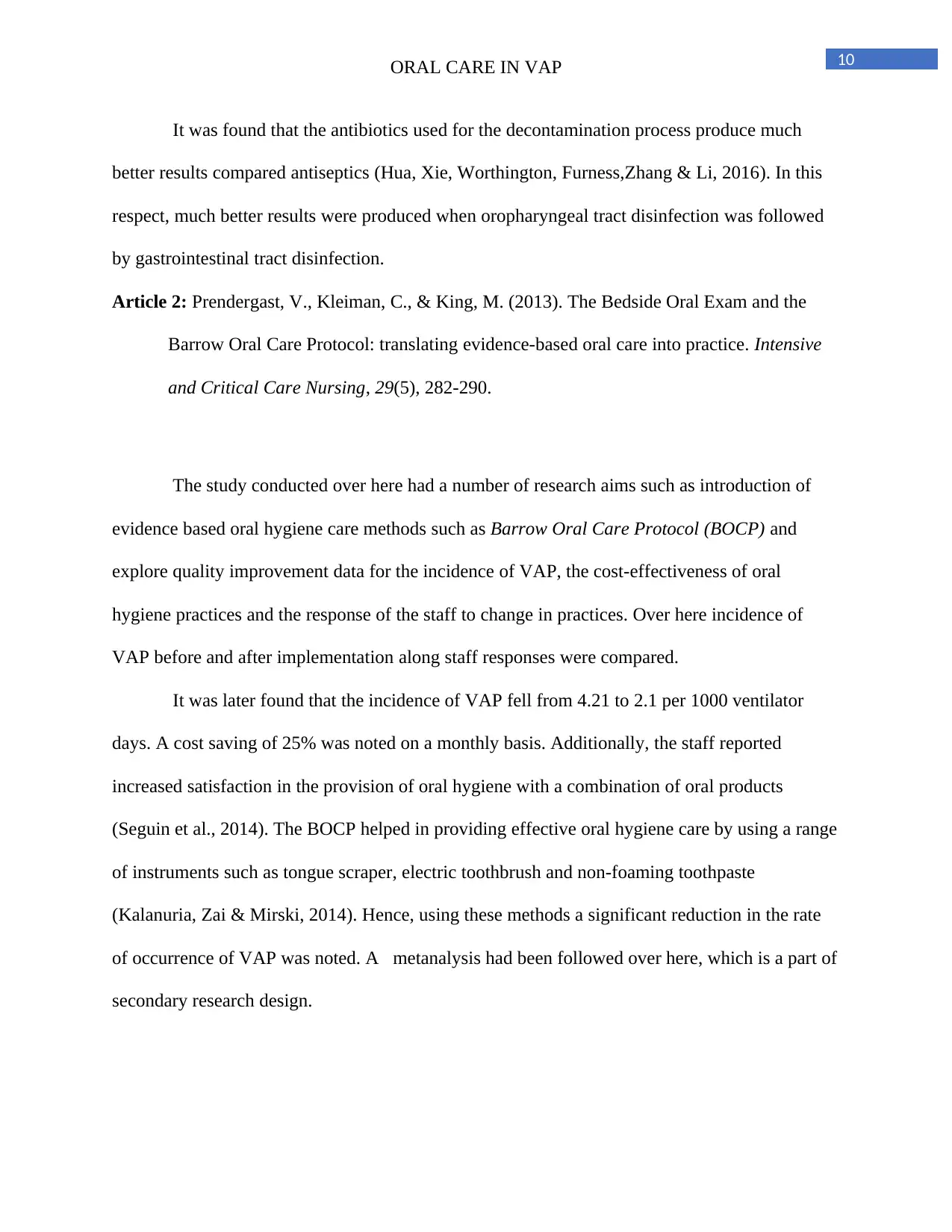
10ORAL CARE IN VAP
It was found that the antibiotics used for the decontamination process produce much
better results compared antiseptics (Hua, Xie, Worthington, Furness,Zhang & Li, 2016). In this
respect, much better results were produced when oropharyngeal tract disinfection was followed
by gastrointestinal tract disinfection.
Article 2: Prendergast, V., Kleiman, C., & King, M. (2013). The Bedside Oral Exam and the
Barrow Oral Care Protocol: translating evidence-based oral care into practice. Intensive
and Critical Care Nursing, 29(5), 282-290.
The study conducted over here had a number of research aims such as introduction of
evidence based oral hygiene care methods such as Barrow Oral Care Protocol (BOCP) and
explore quality improvement data for the incidence of VAP, the cost-effectiveness of oral
hygiene practices and the response of the staff to change in practices. Over here incidence of
VAP before and after implementation along staff responses were compared.
It was later found that the incidence of VAP fell from 4.21 to 2.1 per 1000 ventilator
days. A cost saving of 25% was noted on a monthly basis. Additionally, the staff reported
increased satisfaction in the provision of oral hygiene with a combination of oral products
(Seguin et al., 2014). The BOCP helped in providing effective oral hygiene care by using a range
of instruments such as tongue scraper, electric toothbrush and non-foaming toothpaste
(Kalanuria, Zai & Mirski, 2014). Hence, using these methods a significant reduction in the rate
of occurrence of VAP was noted. A metanalysis had been followed over here, which is a part of
secondary research design.
It was found that the antibiotics used for the decontamination process produce much
better results compared antiseptics (Hua, Xie, Worthington, Furness,Zhang & Li, 2016). In this
respect, much better results were produced when oropharyngeal tract disinfection was followed
by gastrointestinal tract disinfection.
Article 2: Prendergast, V., Kleiman, C., & King, M. (2013). The Bedside Oral Exam and the
Barrow Oral Care Protocol: translating evidence-based oral care into practice. Intensive
and Critical Care Nursing, 29(5), 282-290.
The study conducted over here had a number of research aims such as introduction of
evidence based oral hygiene care methods such as Barrow Oral Care Protocol (BOCP) and
explore quality improvement data for the incidence of VAP, the cost-effectiveness of oral
hygiene practices and the response of the staff to change in practices. Over here incidence of
VAP before and after implementation along staff responses were compared.
It was later found that the incidence of VAP fell from 4.21 to 2.1 per 1000 ventilator
days. A cost saving of 25% was noted on a monthly basis. Additionally, the staff reported
increased satisfaction in the provision of oral hygiene with a combination of oral products
(Seguin et al., 2014). The BOCP helped in providing effective oral hygiene care by using a range
of instruments such as tongue scraper, electric toothbrush and non-foaming toothpaste
(Kalanuria, Zai & Mirski, 2014). Hence, using these methods a significant reduction in the rate
of occurrence of VAP was noted. A metanalysis had been followed over here, which is a part of
secondary research design.
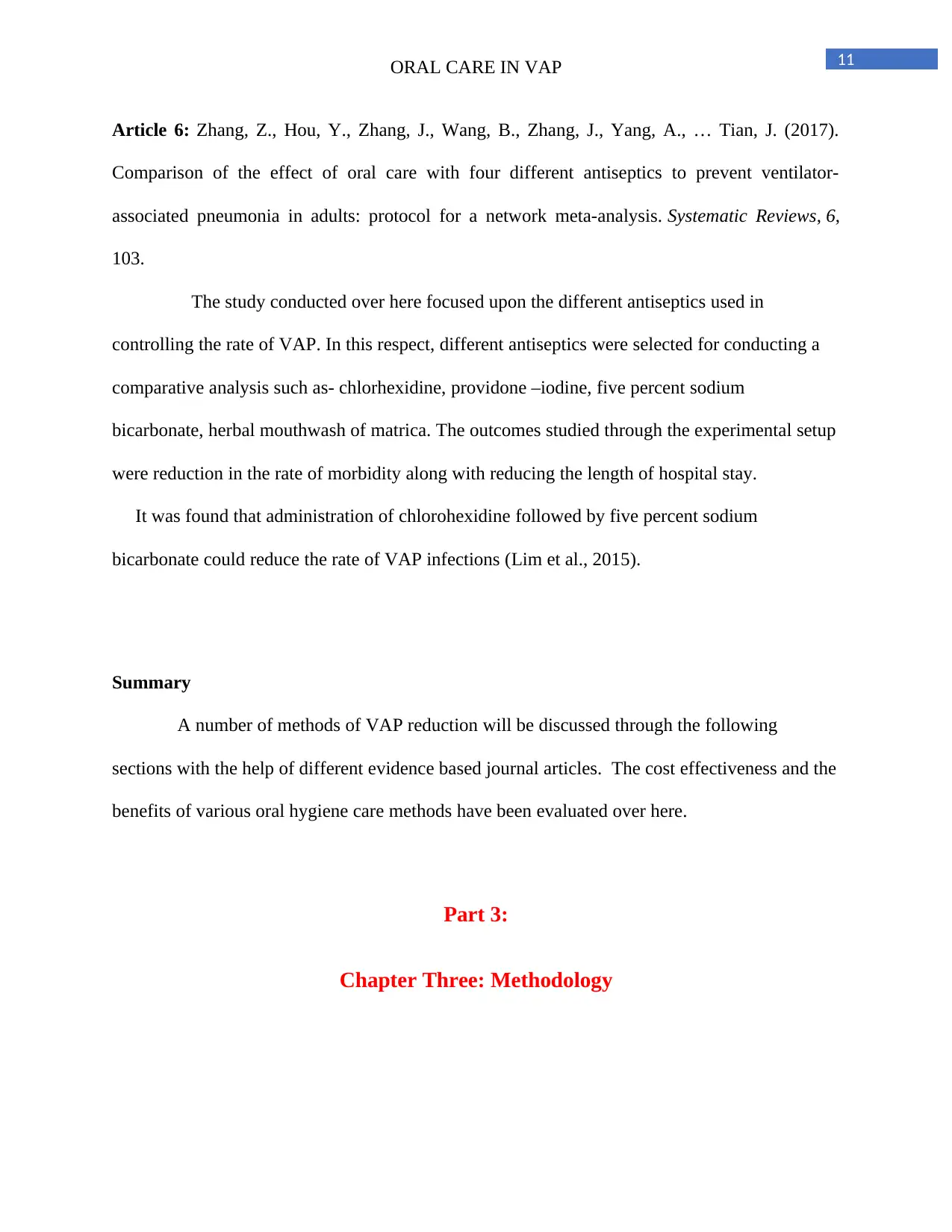
11ORAL CARE IN VAP
Article 6: Zhang, Z., Hou, Y., Zhang, J., Wang, B., Zhang, J., Yang, A., … Tian, J. (2017).
Comparison of the effect of oral care with four different antiseptics to prevent ventilator-
associated pneumonia in adults: protocol for a network meta-analysis. Systematic Reviews, 6,
103.
The study conducted over here focused upon the different antiseptics used in
controlling the rate of VAP. In this respect, different antiseptics were selected for conducting a
comparative analysis such as- chlorhexidine, providone –iodine, five percent sodium
bicarbonate, herbal mouthwash of matrica. The outcomes studied through the experimental setup
were reduction in the rate of morbidity along with reducing the length of hospital stay.
It was found that administration of chlorohexidine followed by five percent sodium
bicarbonate could reduce the rate of VAP infections (Lim et al., 2015).
Summary
A number of methods of VAP reduction will be discussed through the following
sections with the help of different evidence based journal articles. The cost effectiveness and the
benefits of various oral hygiene care methods have been evaluated over here.
Part 3:
Chapter Three: Methodology
Article 6: Zhang, Z., Hou, Y., Zhang, J., Wang, B., Zhang, J., Yang, A., … Tian, J. (2017).
Comparison of the effect of oral care with four different antiseptics to prevent ventilator-
associated pneumonia in adults: protocol for a network meta-analysis. Systematic Reviews, 6,
103.
The study conducted over here focused upon the different antiseptics used in
controlling the rate of VAP. In this respect, different antiseptics were selected for conducting a
comparative analysis such as- chlorhexidine, providone –iodine, five percent sodium
bicarbonate, herbal mouthwash of matrica. The outcomes studied through the experimental setup
were reduction in the rate of morbidity along with reducing the length of hospital stay.
It was found that administration of chlorohexidine followed by five percent sodium
bicarbonate could reduce the rate of VAP infections (Lim et al., 2015).
Summary
A number of methods of VAP reduction will be discussed through the following
sections with the help of different evidence based journal articles. The cost effectiveness and the
benefits of various oral hygiene care methods have been evaluated over here.
Part 3:
Chapter Three: Methodology
⊘ This is a preview!⊘
Do you want full access?
Subscribe today to unlock all pages.

Trusted by 1+ million students worldwide
1 out of 20
Related Documents
Your All-in-One AI-Powered Toolkit for Academic Success.
+13062052269
info@desklib.com
Available 24*7 on WhatsApp / Email
![[object Object]](/_next/static/media/star-bottom.7253800d.svg)
Unlock your academic potential
Copyright © 2020–2025 A2Z Services. All Rights Reserved. Developed and managed by ZUCOL.





